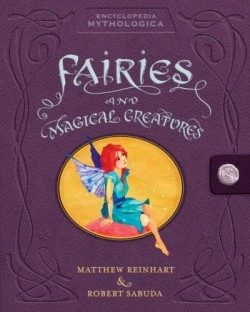
Encyclopedia Mythologica
Fairies and Magical Creatures
- 2008 INDIES Finalist
- Finalist, Picture Books (Children's)
Delight in all things fairy is a bustling industry today, and Encyclopedia Mythologica: Fairies and Magical Creatures is a fascinating little gem of a book that should be on every girl’s “must have” list. Longtime collaborators Matthew Reinhart and Robert Sabuda, both masters of paper engineering with many pop-up books to their joint and individual credit, have created a book that is both marvelously simple, yet wondrously complex. For starters, it is only two pages long.
Shakespeare’s Titania rises majestically to life as the reader opens this amazing centerfold. She stands more than six inches tall, and her skirts, adorned with flowers, billow impressively about her. Her tiara is of flowers, and her wings are a translucent lavender that complements the royal purple of her skirts. In other words, she looks exactly as a fairy queen should.
If one simply turned the page here, the book would be closed, but readers will only take this drastic action after exploring what’s behind the four flaps, or mini-pages in the four corners of this enchanting spread. If one lifts the flap labeled “Origins,” it reveals a human hand, in which stands an example of a European fairy also known as “Small Folk” or “Fay.” The combination of wings and fingers makes this page difficult to close; readers will have to take care.
The myth of the changeling child brings to mind the poet Yeats, who imagined how fairies might lure children away from their homes and families when he wrote “The Stolen Child”: “Come away, O human child! / To the waters and the wild / With a faery, hand in hand, / For the world’s more full of weeping than you can understand.” The text’s explanation that “Peasants in medieval England believed that fairies kidnapped newborns and replaced them with fussy and often sickly babies known as changelings,” is perhaps more prosaic, but the terrifying speed with which a crying baby turns into a hideous fanged monster makes the point well enough.
Open another flap to reveal King Arthur’s Lady of the Lake, who was “sole protector of thirteen Celtic treasures,” including Excalibur. A tiny flap introduces us to the Tooth Fairy, who “may have arisen from a seventeenth-century French tale.”
The authors are also the creators of the Encyclopedia Prehistorica series as well as The Young Naturalist’s Handbook: Insect-lo-pedia. Watch for more from this talented pair!
Reviewed by
Elizabeth Breau
Disclosure: This article is not an endorsement, but a review. The publisher of this book provided free copies of the book to have their book reviewed by a professional reviewer. No fee was paid by the publisher for this review. Foreword Reviews only recommends books that we love. Foreword Magazine, Inc. is disclosing this in accordance with the Federal Trade Commission’s 16 CFR, Part 255.
